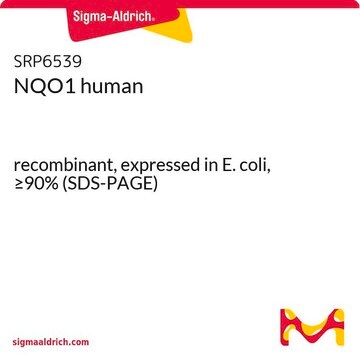F1392
Riboflavin 5′-monophosphate sodium salt hydrate
suitable for electrophoresis, suitable for acrylamide photopolymerization, ≥70%, powder
Synonym(s):
FMN-Na, Flavin mononucleotide, Riboflavin 5′-phosphate sodium salt
About This Item
Recommended Products
Assay
≥70%
form
powder
optical activity
[α]20/D +37 to +42°, c = 1.5 in 5 M HCl(lit.)
technique(s)
electrophoresis: suitable
solubility
H2O: soluble 50 mg/mL, clear, orange
ε (extinction coefficient)
12.5 at 445 nm at 1 mM
suitability
suitable for acrylamide photopolymerization
foreign activity
Protease, none detected
storage temp.
−20°C
SMILES string
O.[Na+].Cc1cc2N=C3C(=O)NC(=O)N=C3N(C[C@H](O)[C@H](O)[C@H](O)COP(O)([O-])=O)c2cc1C
InChI
1S/C17H21N4O9P.Na.H2O/c1-7-3-9-10(4-8(7)2)21(15-13(18-9)16(25)20-17(26)19-15)5-11(22)14(24)12(23)6-30-31(27,28)29;;/h3-4,11-12,14,22-24H,5-6H2,1-2H3,(H,20,25,26)(H2,27,28,29);;1H2/q;+1;/p-1/t11-,12+,14-;;/m0../s1
InChI key
BHRVCJBIICJWTH-APQIITSESA-M
Looking for similar products? Visit Product Comparison Guide
Related Categories
Application
- to study its mechanism of inhibition of mutagenicity of a benzo[a]pyrene 7,8-diol 9,10-epoxide, a carcinogenic metabolite of benzo[a]pyrene
- along with flavin adenine dinucleotide for reactivation of the enzyme that catalyzes the oxidation of pyridoxamine to pyridoxal in a study
- to study the reduction of polymeric azo and nitro dyes by intestinal bacteria
- to study the effect of FMN on ferrisiderophore reductase activity in the cytoplasmic fraction of Agrobacterium tumefaciens.
Biochem/physiol Actions
FMN is suitable as a photopolymerization reagent in polyacrylamide gel electrophoresis (PAGE) by forming free radicals in aqueous solution in the presence of light. FMN photodecomposes to leucoflavin. No free radicals are formed in the absence of oxygen, but traces of oxygen allow for leucoflavin to reoxidize with free-radical generation. The catalysts, tetramethylethylenediamine (TEMED) or 3-dimethylaminopropionitrile (DMAPN), are commonly added to speed up the free radical formation. Free radicals will cause acrylamide and bis-acrylamide to polymerize to form a gel matrix which can be used for sieving macromolecules. FMN is commonly used in the stacking gel for non-denaturing PAGE because native proteins can be sensitive to persulfate ions from ammonium persulfate. Another advantage of FMN over ammonium persulfate is that it will not start polymerizing until the gel is illuminated.
Storage Class Code
11 - Combustible Solids
WGK
WGK 1
Flash Point(F)
Not applicable
Flash Point(C)
Not applicable
Personal Protective Equipment
Certificates of Analysis (COA)
Search for Certificates of Analysis (COA) by entering the products Lot/Batch Number. Lot and Batch Numbers can be found on a product’s label following the words ‘Lot’ or ‘Batch’.
Already Own This Product?
Find documentation for the products that you have recently purchased in the Document Library.
Customers Also Viewed
Our team of scientists has experience in all areas of research including Life Science, Material Science, Chemical Synthesis, Chromatography, Analytical and many others.
Contact Technical Service




